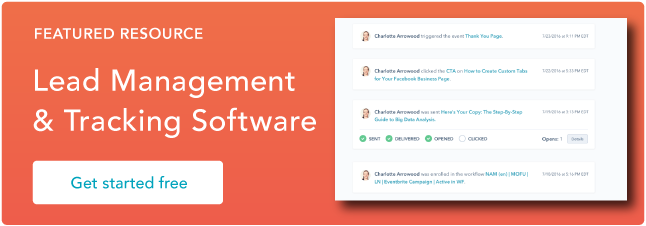MQL
In this post, we'll talk about what an MQL is, why identifying MQLs is worthwhile, and MQL criteria you can establish on your team.
How does the qualification process for an MQL work?
At a high level, a lead becomes an MQL, then a SQL, working their way down the funnel until they (hopefully) become a customer.
As mentioned, if a lead becomes an MQL, they've been vetted by the marketing team. In other words, the marketing team determines whether or not they believe sales would have a good chance at successfully nurturing and converting a specific lead into a customer.
If the sales team does agree with the marketing team — and believes they have a good chance of converting an MQL into a customer — then that MQL becomes a sales qualified lead (SQL).
Why You'd Want to Mark a Lead as an MQL
Whether through a content offer, social post, virtual or in-person event, web page, blog post, subscription, podcast, or ad, marketing has many potential touchpoints with leads, prospects, and target audience members before anyone else at your business does.
The resulting engagement data (and contact information, if any) is vital to the success of your business. It's how your marketing team can efficiently sift through those prospects to identify the highest-quality leads based on criteria (which we'll talk more about below) set by your business.
Once marketing has identified MQLs for your business, then can send them along to your sales team — this propels sales through the initial steps of their roles (e.g. discovery and prospecting), and provides them with leads their marketing counterparts believe are worthwhile.
Sales then performs their own qualification process and pulls out the top-tier prospects from that list of MQLs.
Not only does this save sales reps time, but it also ensures marketing and sales are aligned on who your buyer personas are, what type of marketing content brings the right prospects for your business in, and more.
Marketing Qualified Lead Criteria
Setting accurate MQL criteria is how you ensure your sales team is sent leads of the highest quality. Establishing these criteria is also worthwhile because it helps marketing determine which type of marketing materials, content, and offers will do best among your audience members who fit that criteria. In other words, establishing solid MQL criteria is a win-win for both marketing and sales.
How to Establish With MQL Criteria (Plus Examples of MQL Criteria)
1. Establish a working marketing and sales team relationship.
As mentioned several times throughout this article, a major aspect of MQL success is the process of maintaining open communication and alignment between the marketing and sales teams. Marketing cannot target or identify high-quality leads without aligning with sales. And sales will not have access to MQLs without the help of marketing.
You might start by reiterating the importance of this relationship to the marketing and sales orgs so they understand the value that will come from cross-team communication.
Then, you might set recurring meetings to discuss alignment as well as roles and areas for potential growth (e.g. which marketing content is working best among prospects, which enablement materials sales feels like they're missing, or prospect feedback that reps get directly from the source and can share with marketers to help their campaign targeting, etc.).
There may be a dedicated amount of time during these meetings for discussion about how to improve the marketing and sales relationship and alignment, and another portion of time set aside for feedback, ideation, and fact sharing.
2. Create lead definitions.
Marketers and salespeople should also work together to develop lead definitions for your business. Meaning, marketing should meet with sales to identify, explain, and record the main characteristics and traits that make up an MQL on your team.
For example, your marketing managers may meet with your sales managers to create a definition of an MQL. This process will look likely look a lot like the process you used to develop your buyer personas.
Here are some examples of questions to ask while defining MQLs:
- What type of marketing content should be engaged with in order to define someone as an MQL?
- Which specific defining traits (demographic and firmographic) are necessary to call someone an MQL?
- Which pain points or challenges should a person have to make them an MQL?
Based on the lead definitions you create, you can go a bit deeper and assign point values for various MQL qualifications in order to form the basis of a lead scoring system. This will ensure your sales team is delivered high-quality leads in an organized fashion so they stay as productive as possible.
3. Revisit your lead definitions and regularly.
Not only do your business, internal teams, and customer base grow in size over time, but your prospects, buyer personas, and leads also evolve. That's why it's so important to circle back to your lead definitions regularly and update them as needed.
For instance, maybe your marketing team revisits your lead definitions quarterly — they may review them as a team and then present any changes they believe are necessary to sales in order to get their feedback. Or maybe marketing and sales review the definitions together and update them accordingly in a collaborative meeting.
Either way, remember that just because something works for you now doesn't mean it'll be something that works for you in the future. Be cognizant of the fact that your lead definitions will need updating in order to ensure marketing is targeting, identifying, and presenting high-quality leads for and to sales reps.
Start Creating and Using MQLs
Now that you see the power of MQLs, it's time to start creating your own. Think about the tips we covered above to get started identifying and converting more qualified leads.
Editor's note: This post was originally published in June 2018 and has been updated for comprehensiveness.
Marketing Operations



![Everything You Need to Know About Behavioral Segmentation [+ Examples]](https://53.fs1.hubspotusercontent-na1.net/hubfs/53/GettyImages-1416048929.jpg)






